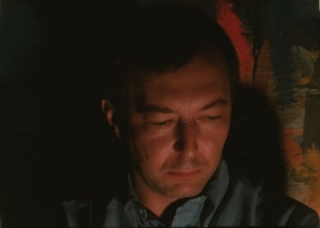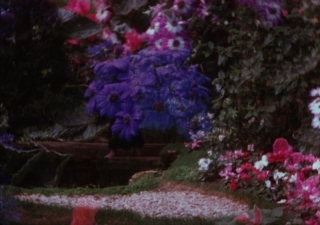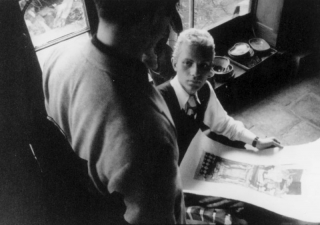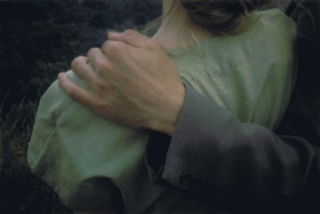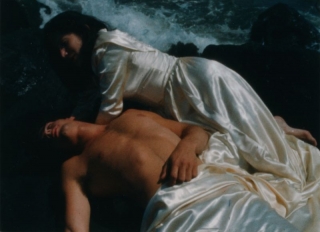Date: 13 September 2014 | Season: Gregory Markopoulos: Film as Film | Tags: Gregory Markopoulos
GREGORY J. MARKOPOULOS: FILM AS FILM 4
Saturday 13 September 2014, at 3pm
New York Anthology Film Archives
Inspired by the legend of Faust, Genius is a triple-portrait of three significant art world figures – the British artist David Hockney, the Argentinian surrealist painter Leonor Fini, and the German-born art dealer Daniel-Henry Kahnweiler, an important early supporter of the Cubists. With its measured structure, carefully spacing images between passages of clear or opaque film, Genius forms the central section of the third cycle of Eniaios. This 80-hour long silent film, one of the most remarkable and ambitious projects in the history of cinema, is intended to be shown only at the remote site in Greece chosen by Markopoulos as the ideal setting for his work.
Gregory J. Markopoulos, Genius (from Eniaios III), 1970, 86 min
“In film, in the beautiful, stupid past of the commercial film with its total lack of creative achievement, though stated otherwise by film historians, the absolute Barbarians of our diminishing cultural age, the film construction was dependent on the story in the guise of the necessary message; the necessary message impounded for the benefit, that is the enlightenment and therefore the deliberate enslavement of the filmgoer. However, in my finished work, entitled Genius, the development is along absolute philosophical lines. For instance the three unsuspecting figures who became my characters, represent, in their own milieu, the crises of our times. I refuse to say more. Perhaps, I do not know more! Suffice to say, that even as I was filming, I knew: we look at a face, at the gestures, and we know, if we so wish, the content of the inner being.” (Gregory J. Markopoulos, The Redeeming of the Contrary, 1973)
Date: 16 September 2014 | Season: Gregory Markopoulos: Film as Film | Tags: Gregory Markopoulos
GREGORY MARKOPOULOS: GALAXIE
Tuesday 16 September 2014, at 7:30pm
Brooklyn Light Industry
“What Truman Capote has done with two murderers in cold blood, Gregory Markopoulos has done with 33 Greenwich Villagers: fictionalised the living human being. Galaxie, the latest work of biophotography stemming from the mind of Joyce, the vision and brush of Picasso, and the urbanely-romantic camera of Markopoulos.” (George Christopoulos, “Cinemaportraits – Markopoulos Galaxie”, Film Culture No. 42, Fall 1966)
Gregory Markopoulos, Galaxie, 16mm, 1966, 92 mins
In 1966, Gregory Markopoulos filmed portraits of notable figures in the New York art world, including painters, poets, critics, filmmakers, and choreographers. Markopoulos populated his Galaxie with a remarkable constellation of personalities, ranging from those in his immediate circle of filmmakers (Jonas Mekas, Storm de Hirsch, the Kuchar Brothers) to luminaries from other art forms (Jasper Johns, W. H. Auden, Allen Ginsberg). Each is shot with a single roll of 16mm film and, though edited entirely in-camera in the moment of filming, comprises many layers of dense superimpositions that build a complex portrait of the sitter. The subjects were invited to pose in their home or studio, together with personal objects of their choice: Parker Tyler is a seen with a drawing by Tchelitchew, Susan Sontag with photographs of Garbo and Dietrich, Shirley Clarke and Maurice Sendak both with children’s toys, Gregory Battcock with a Christmas card and zebra rug. The film is silent except for the sound of a Hindu bell, its number of rings increasing incrementally until 30 chimes accompany the final portrait.
With this new form of portraiture, Markopoulos developed a detached but empathetic middle ground between the cool objectivity of Warhol’s Screen Tests and the informal portrayals of friends seen in the diary films of Mekas. The portrait would subsequently become a prevalent aspect of Markopoulos’ filmmaking for works such as Through a Lens Brightly: Mark Turbyfill, Political Portraits, Index: Hans Richter and Saint Actaeon. Genius, his interpretation of Faust (screening at Anthology Film Archives on Sep 13) consists only of portraits of Leonore Fini, David Hockney, and Daniel Henry Kahnweiler. Many such studies were later incorporated in his monumental, final work Eniaios.
This screening celebrates the publication of Film as Film: The Collected Writings of Gregory J. Markopoulos, edited by Mark Webber with a foreword by P. Adams Sitney, published by The Visible Press, London.
Date: 17 September 2014 | Season: Gregory Markopoulos: Film as Film | Tags: Gregory Markopoulos
THE ILLIAC PASSION
Wednesday 17 September 2014, at 7pm
International House Philadelphia
Throughout his life, Markopoulos remained closely connected to his heritage and ultimately saw the Greek landscape as the ideal setting for viewing his films. The Illiac Passion, one of his most highly acclaimed films, is a visionary interpretation of ‘Prometheus Bound’ starring mythical beings from the 1960s underground. The soundtrack of this contemporary re-imagining of the classical realm features a reading of Thoreau’s translation of the Aeschylus text and excerpts from Bartok.
Gregory Markopoulos, The Illiac Passion, 1964-67, 92 min
“The Illiac Passion, which features chiaroscuro passages reminiscent of Anger’s Inauguration of the Pleasure Dome of 1954, and incorporates 25 characters, is loosely based on Aeschylus’ ‘Prometheus Bound’. For a viewer seeing this extravagant ode to creation some thirty years after its making, the film’s most plangent moments involve Markopoulos’ affectionate casting of friends as mythical figures – Andy Warhol’s Poseidon pumping on an Exercycle above a sea of plastic, Taylor Mead’s Demon leaping, grimacing, and streaming vermilion fringes, and Jack Smith’s bohemian Orpheus, spending a quiet afternoon at home with Eurydice.” (Kristin M. Jones, Artforum)
Introduced by Mark Webber. Co-presented with Cinema Studies at the University of Pennsylvania.
Date: 19 September 2014 | Season: Gregory Markopoulos: Film as Film | Tags: Gregory Markopoulos
FILM AS FILM: THE CINEMA OF GREGORY MARKOPOULOS
19 September—5 October 2014
Cambridge Harvard Film Archive
Gregory J. Markopoulos (1928-92) was one of the most original filmmakers to emerge in post-war American cinema. His films, which often translated literary or mythological sources to a contemporary context, are celebrated for their extraordinary creativity, the sensuous use of colour and innovations in cinematic form. This latest instalment of HFA’s on-going retrospective sees the filmmaker at a critical point in his development – the moments of transition between the works that consolidated his reputation in the USA and those made following his move to Europe. It also presents his earliest films from the 1940s, including the trilogy Du sang, de la volupté et de la mort. Commencing with his first 16mm film, Psyche, which took as its source the unfinished novella by Pierre Louÿs, the work is completed by Lysis and Charmides, both inspired by Platonic dialogues.
At the peak of his success in the mid-1960s, Markopoulos began filming The Illiac Passion, a long-planned version of Prometheus Bound. This ambitious project took three years to complete, during which time the direction of Markopoulos’ filmmaking had begun to shift from the more narrative interpretations of mythic themes towards portraiture and studies of landscapes and architecture. One of Markopoulos’ last literary adaptations (and one of his last American films) was Himself as Herself, an exploration of androgyny loosely based on Balzac’s Séraphîta that was shot in Boston in 1966. In New York, he filmed thirty important art world figures for Galaxie, amongst them Jasper Johns, WH Auden, Susan Sontag and Allen Ginsberg. Its lapidary nature is constructed through the use of multiple superimpositions that were done in-camera at the moment of filming – a technique also explored in ‘films of place’ such as Ming Green and Bliss.
In 1968, as a result of his growing disillusionment with the culture that had developed around avant-garde cinema, Markopoulos decided to leave the USA and spend the rest of his life in Europe with his partner Robert Beavers. There, he made plans for Temenos, a unique monographic archive for the preservation, presentation and study of his work. Born out of the desire for continuity between the production, presentation, and analysis of his films, Temenos proposes an ideal in which a projection space, the film copies, and the filmmaker’s writings and documentation can exist in close proximity.
This comprehensive resource was drawn upon to provide the material for “Film as Film: The Collected Writings of Gregory J. Markopoulos”, an indispensable new publication which brings together over 90 different texts written by the filmmaker between 1950 and 1992. In these essays, Markopoulos chronicles the burgeoning New American Cinema scene and responds to auteurs such as Dreyer, Bresson and Mitzoguchi. He also writes in detail on the genesis of his own films and the early work of Robert Beavers. The most individualistic and poetic texts are devoted to his aspirations for the medium of film, and the speculative project of Temenos.
To celebrate the publication, a discussion between its editor Mark Webber, the scholar P. Adams Sitney and filmmaker Robert Beavers will follow the screening of Gammelion, Markopoulos’ elegant film of the castle of Roccasinibalda, which employs an intricate system of fades to extend five minutes of footage to an hour of viewing time. This inventive technique, in which brief images appear amongst measures of black and clear frames, was a crucial step towards the structure his monumental, final work. Eniaios is represented in the season by Hagiographia II, in which the filmmaker returns to his Hellenic roots to film the Byzantine city of Mistra in the Peloponnese, and by Genius (a version of Faust featuring David Hockney, Leonore Fini, Daniel Henry Kahnweiler) and his 1975 portrait of the artists Gilbert and George.
Mark Webber
For further information on Markopoulos, please see the introduction to A Gregory Markopoulos Prelude, the previous season of his films at HFA in April 2014. Film as Film: The Collected Writings of Gregory J. Markopoulos, edited by Mark Webber with a foreword by P. Adams Sitney, is published by The Visible Press, London.
Date: 19 September 2014 | Season: Gregory Markopoulos: Film as Film | Tags: Gregory Markopoulos
FILM AS FILM: THE CINEMA OF GREGORY MARKOPOULOS 1
Friday 19 September 2014, at 7pm
Cambridge Harvard Film Archive
“To be loved means to be consumed. To love means to radiate with inexhaustible light. To be loved is to pass away, to love is to endure.” (Text by Rainer Maria Rilke, recited on the soundtrack of Gammelion.)
Gregory J. Markopoulos, Bliss, 1967, 6 min
An exquisite portrait of the interior of a Byzantine church on the Greek island of Hydra, edited in-camera in the moment of filming.
Gregory J. Markopoulos, Gammelion, 1968, 55 min
Markopoulos’ elegant film of the castle of Roccasinibalda in Rieti, Italy, (then owned by patron, publisher and activist Caresse Crosby) employs an intricate system of fades to extend five minutes of footage to an hour of viewing time. This inventive new film form, in which brief images appear amongst measures of black and clear frames, was a crucial step towards Markopoulos’ monumental final work Eniaios (1947-91).
Followed by a conversation with P. Adams Sitney, Mark Webber and Robert Beavers.
Date: 20 September 2014 | Season: Gregory Markopoulos: Film as Film | Tags: Gregory Markopoulos
FILM AS FILM: THE CINEMA OF GREGORY MARKOPOULOS 2
Saturday 20 September 2014, at 7pm
Cambridge Harvard Film Archive
Introduced by Mark Webber
Gregory J. Markopoulos, Himself as Herself, 1967, 60 min
“Loosely based on Balzac’s novel Seraphita but merging its male and female protagonists, the film is at once melancholy and transcendent, laden with the gloom of what Markopoulos termed the character’s denial of self but also alive with the possibility of transformation. Clad in formal attire, the young hero seems the essence of maleness, yet he’s troubled by vaguely feminine objects – a fluttering fan, a gold-colorred foot standing on fur. Soon his masculine and feminine selves are intercut, the latter signaled not by drag but by a simple sari, as each of his identities appears to look and gesture at the other. The images are tinged with a powerful if partially suppressed eroticism, yet the plush interiors (this is a rich young man) trap us in a deadened world of opulence, the thick colors embedding the character in the decor. Most important, Markopoulos’s radical editing intercuts two or three scenes, sometimes in a single-frame flicker, which undermines the stability of any one locale or person, each image poised to escape its immediate moment.” (Fred Camper)
Gregory J. Markopoulos, The Dead Ones, 1949, 28 min
Markopoulos’ first attempt at making a 35mm feature film, clearly inspired by the cinema of Jean Cocteau, was left unfinished and the materials were lost for many years.
Gregory J. Markopoulos, Through a Lens Brightly: Mark Turbyfill, 1967, 15min
The life of painter, dancer and poet Mark Turbyfill, seen in his 70th year, is evoked through Markopoulos’ unique form of cinematic portraiture.
Date: 21 September 2014 | Season: Gregory Markopoulos: Film as Film | Tags: Gregory Markopoulos
FILM AS FILM: THE CINEMA OF GREGORY MARKOPOULOS 3
Sunday 21 September 2014, at 4:30pm
Cambridge Harvard Film Archive
Introduced by Mark Webber and Roy Grundmann
Gregory J. Markopoulos, Galaxie, 1966, 82 min
Galaxie is his intimate record of cultural luminaries in mid-1960s New York: 33 painters, poets, filmmakers, choreographers, and critics, including W. H. Auden, Jasper Johns, Susan Sontag, Paul Thek, Maurice Sendak, Shirley Clarke, George and Mike Kuchar, and Allen Ginsberg, whom he observed in their studios or homes and filmed in a single session. While Andy Warhol had his Screen Tests, and Brakhage and Jonas Mekas were also making their own beautiful film portraits, Markopoulos perfected a technique of layering and editing within his Bolex camera that had the effect, he noted, of making “the idea and the image more concentrated; the result a more brilliant appeal to the mind and dormant senses.” (Museum of Modern Art, New York)
Date: 22 September 2014 | Season: Gregory Markopoulos: Film as Film | Tags: Gregory Markopoulos
FILM AS FILM: THE CINEMA OF GREGORY MARKOPOULOS 4
Monday 22 September 2014, at 7pm
Cambridge Harvard Film Archive
Introduced by Robert Beavers
Gregory J. Markopoulos, A Christmas Carol, 1940, 5 min
Gregory J. Markopoulos, Christmas USA, 1949, 8 min
Gregory J. Markopoulos, Du Sang, de la volupté et de la mort, 1947-48, 70 min
Made as a USC student in Los Angeles, Markopoulos’ first 16mm film Psyche took as its source the unfinished novella of the same name by Pierre Louÿs. Shown together with Lysis and Charmides (both made on his return to Toledo, Ohio, and inspired by Platonic dialogues), it forms the trilogy titled Du sang de la volupte et de la mort (1947-48). By boldly addressing lesbian and homosexual themes, the trilogy gained unwelcome notices in Films in Review and Variety where, in the repressive atmosphere of the early 1950s, it was branded “degenerate” following a screening at NYU. Such a response is unimaginable today for lyrical works that express sensuality through the symbolic use of color and composition. Writing about these early films, Markopoulos chose to quote a statement by philosopher and theologian Mircea Eliade, offering viewers a clue to his entire body of work: “The whole man is engaged when he listens to myths and legends; consciously or not, their message is always deciphered and absorbed in the end.” The programme also includes his earliest film, an interpretation of Dickens made when the Markopoulos was only eight years old, and Christmas USA, in which documentary and fiction are woven together to convey a moment of awakening in the mid-West at the end of the 1940s. (Mark Webber)
Date: 28 September 2014 | Season: Gregory Markopoulos: Film as Film | Tags: Gregory Markopoulos
FILM AS FILM: THE CINEMA OF GREGORY MARKOPOULOS 5
Sunday 28 September 2014, at 4:30pm
Cambridge Harvard Film Archive
“Beloved spectators of my distant Temenos, what evolved was the ultimate concern for the medium of film. A continuous working decision not to betray you as film spectators; not to impose a message in your laps. But to deposit before you on a virile screen the very depths which concerned the present work in such a manner that you might one day at its presentation realize that I have been concerned always for you. I now repeat again the word, an effortless illusion and triumph with the legend of Faust; and, with the future film spectator of the Temenos supplying the very brilliance.” (Gregory J. Markopoulos)
Gregory J. Markopoulos, Genius, 1970/1989-91, 60 min
Portraits of the artists David Hockney and Leonor Fini are intercut with one of art dealer Daniel-Henry Kahnweiler. Initially Markopoulos shot three autonomous portraits, but he quickly came to believe that he had been making a version of Faustwithout realizing it. He first called the film The Illuminations of Faust and later settled on Genius. In his essay ‘The Redeeming of the Contrary’, published in the Spring 1971 issue of Film Culture, Markopoulos stressed the ambiguity of his creation and the intuitive nature of his working processes: “I had no idea that these three figures of the art world … would become the very elements of my Faust. And yet they did. They evolved, once the decision was made, effortlessly.” The spontaneity of this evolution from autonomous portraits of figures “sitting in their own rooms” lies at the core of what Markopoulos took to be his gift to his future audience. (P. Adams Sitney)
Gregory J. Markopoulos, Gilbert and George, 1975/1989-91, 12 min
A portrait of the British artists, two living sculptures, filmed in Paris on the occasion of their exhibition at the Sonnabend Gallery. (Mark Webber)
Date: 28 September 2014 | Season: Gregory Markopoulos: Film as Film | Tags: Gregory Markopoulos
FILM AS FILM: THREE FILMS BY GREGORY J. MARKOPOULOS
Sunday 28 September 2014, at 7pm
Basilica Hudson
Celebrating the publication of Film as Film: The Collected Writings of Gregory J. Markopoulos (The Visible Press), filmmaker Robert Beavers, and the book’s editor Mark Webber will present a very rare screening of three early Markopoulos films that were made in the United States in the mid-1960s.
Gregory J. Markopoulos, Ming Green, 1966, 7 min
Gregory J. Markopoulos, Twice a Man, 1963, 48 min
Gregory J. Markopoulos, Through a Lens Brightly: Mark Turbyfill, 1967, 14 min
Co-presented by Basilica Hudson and the Film and Electronic Arts Department at Bard College.
PROGRAMME NOTES
FILM AS FILM: THREE FILMS BY GREGORY J. MARKOPOULOS
Sunday 28 September 2014, at 7pm
Basilica Hudson
MING GREEN
Gregory J. Markopoulos, 1966, 16mm, colour, sound, 7 min
Dedicated to Stan Brakhage. Music: Traumen / Wesendonck Lieder by Richard Wagner. Filmed in New York City.
“An extraordinary self-portrait conveyed through multiple layered superimpositions of the filmmaker’s sparsely furnished room in Greenwich Village.” (Mark Webber)
TWICE A MAN
Gregory J. Markopoulos, 1963, 16mm, colour, sound, 48 min
Based on the story of Hippolytus. Featuring Paul Kilb, Olympia Dukakis, Albert Torgesen. Music: Excerpt from Manfred Symphony, op. 58 by Pyotr Tchaikovsky. Filmed in New York City, Staten Island, Long Island and Bear Mountain Park.
“Twice A Man is a fragmented re-imagining of the Greek myth of Hippolytus, who was killed after rejecting the advances of his stepmother. Markopoulos’ vision transposes the legend to 1960s New York and has its main character abandon his mother for an elder man. Employing sensuous use of colour, the film radicalised narrative construction with its mosaic of ‘thought images’ that shift tenses and compress time. One of the touchstones of independent filmmaking, Twice A Man was made in the same remarkable milieu as Scorpio Rising and Flaming Creatures by a filmmaker named ‘the American avant-garde cinema’s supreme erotic poet’ by its key critic P. Adams Sitney.” (Mark Webber)
THROUGH A LENS BRIGHTLY: MARK TURBYFILL
Gregory J. Markopoulos, 1967, 16mm, 15 min
Featuring Mark Turbyfill. Filmed in Chicago.
“The life of painter, dancer and poet Mark Turbyfill, seen in his 70th year, is evoked through traditional portraiture and personal objects.” (Mark Webber)
Back to top

